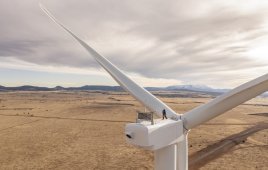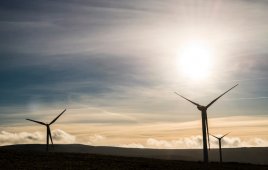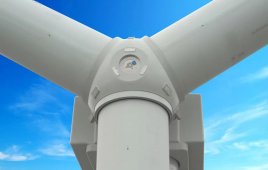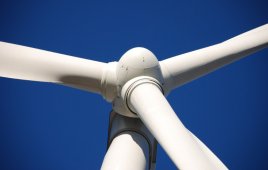The power cable in a nacelle may have a tougher job than the exposed wires on electric lines. In a nacelle, the power cable, from a generator has to tolerate millions of twists, oil, and cold winter temperatures. An improved tolerance to each of these conditions describe cable trends.
Wind turbines transmit power from their generators to ground-based equipment through large cables capable of handling many Amps. But there are no slip rings to get this power out of a turning nacelle. To accommodate the necessity of yaw, the cable is run up the side of tower, over a 180° strain relief, into about 3-m long loop and then into the nacelle. This “slack” accommodates nacelle motion. But as you can imagine, in cold weather, cables stiffen, so the stranded copper conductors and insulation are a composition that should stay flexible. “Tests our company conducts in Europe involves 5 million twists at about five rpm,” says Lapp USA Senior Product Manager Rick Orsini.
Improved tolerance to cold weather is the cable trend. “At -40°C, cable insulation can become so brittle it will break off and expose conductors. One lab test calls for dropping a small weight on a cable frozen to -40°C. It shatters the insulation as if it were glass. That temperature is extreme but possible in turbines in cold weather regions,” says Orsini.
Another cabling trend is toward insulation that tolerates gear oil. Depending on the insulation material, with sufficient exposure to oil, insulation can swell and flake off, or become brittle and break off, again exposing conductors. Although gearboxes have improved in recent years, they still use oil that must be changed on occasion and that invites drips and spills that can find their way down that big cable loop below the nacelle. One company says oil spills in the nacelle are unavoidable.
No surprise that OEMs are looking for price concessions, perhaps the most universal trend. Turbine manufacturers setting up production in the U.S. often ask for halogen-free cable insulations. Halogen-free materials are often considered because if exposd to flame, they would not outgas harmful compounds to nearby technicians. “However, considering that it is unlikely that anyone would be in a nacelle should a fire break out, the necessity of more expensive halogen free materials becomes less important,” says Orsini. PVC based insulation are less expensive and provide the oil and temperature performance needed. So far, adds Orsini, his company has been able to produce a halogen-free insulation good to -25°C.
Of course as turbines are getting larger, their voltage outputs are also going up. UL WTTC (wind turbine tray cable) standard 1227 got frequent sited for 600V cables it describes. The more recent WTTC 2227 now describes 1,000V cables.
What happens when a cable is exposed to flame is on the mind of other manufacturers as well. Lubrizol says it developed a thermoplastic polyurethane for cable jacketing and molding that delivers a Limited Oxygen Index (LOI) of 40. The material has a Shore hardness of 53D, and is UL-94 rated for V-0 on the vertical burn of a 75-mil sample thickness.
Getting cables through bulkheads while maintaining water and oil tightness is also getting attention. One multi-cable bushing system is said to provide better way to seal and clamp cables than competitive designs, and with simplified service. Users install a frame to an enclosure wall just once. The frame has individual passage for each of 8 to 10 cables, each accommodates standard 16 or 24 pole connectors. Manufacturer Lapp USA says each cable has high pullout resistance with compression modules. The device’s advantage is faster repairs because the frame remains on the housing at all times, and it requires no special tools, sealants, or lubricants.
WPE
Filed Under: Cables & connectors, Nacelle, Turbines





Slip ring is one of the important parts of the automation control system, and its performance is directly related to the stability of the whole system running, even normal operation
more information:http://www.moflon.com
Thanks Mr.George Fleming for intresting update.
The best solution to the twisting problem is to eliminate it by installing the generator at ground level. There is a way to this which has other benefits. See comments at
http://www.businessgreen.com/print_article/bg/news/2025406/vestas-unveil-6mw-offshore-plan
Dear All,
Still we dont have correct solution for Power cables in Wind turbine. How to solve the problem of Cable insulation damage due to twisting of cables.
Cables are fixed by cable tie, however during the twisting cable tie create abbration and it results into insualtion damage.
Any solution??
Kartik